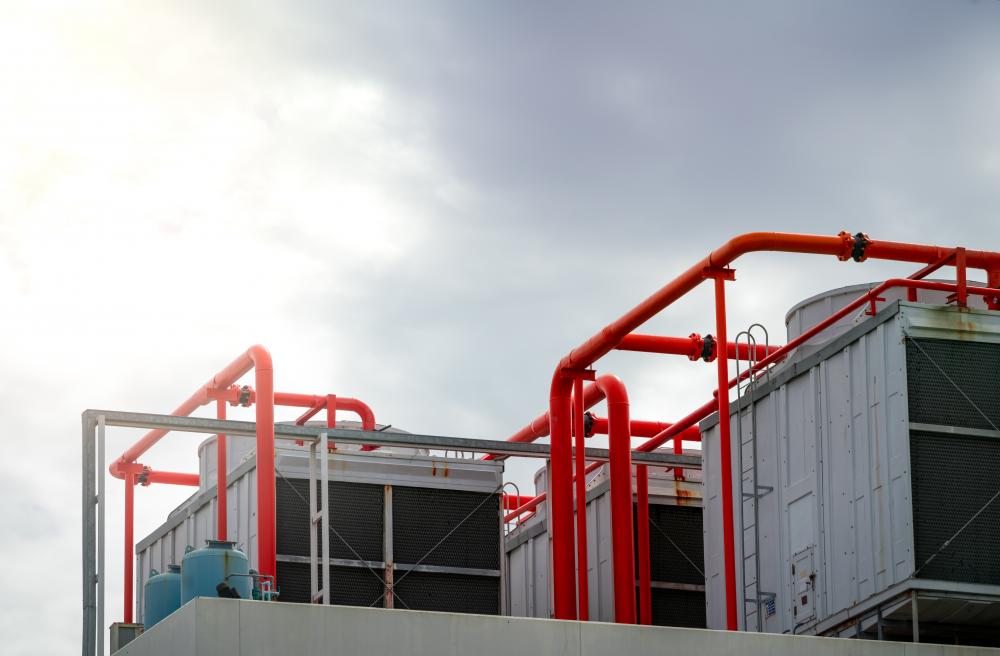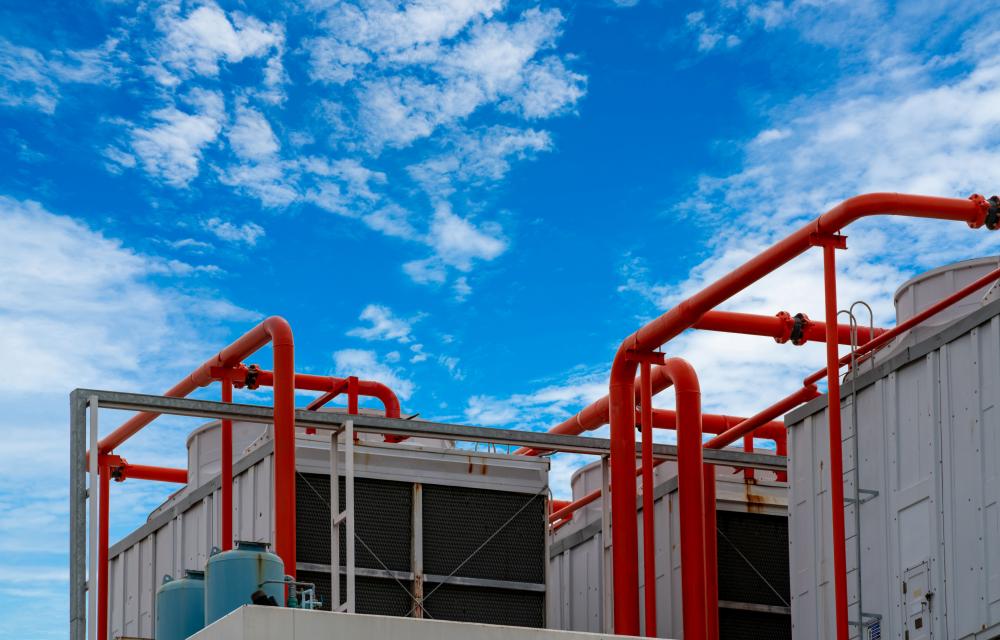
Understanding Building Chiller
At B.I.M.S., Inc., we’ve seen firsthand the pivotal role that a Building Chiller plays in maintaining the optimal environment within commercial and industrial structures. Having been in the HVAC-R industry for over 45 years, our journey has granted us the insight and experience to appreciate the intricate dance between technology and application in achieving efficient cooling solutions. This exploration aims to shed light on the intricacies of Building Chillers, breaking down their operation, types, and the unique benefits they offer.
Types of Building Chillers
What Variety Do We Encounter?
Primarily, Building Chillers fall into two broad categories: air-cooled and water-cooled chillers. Each type serves the same purpose but follows a distinct operational path to achieve cooling. Our technicians, carrying the prestigious Texas Air Conditioning Contractors License, frequently encounter both types, ensuring they resonate with the specific needs of a facility.
Air-Cooled Chillers
These chillers are often praised for their lower initial installation cost and simplicity. They expel heat directly into the atmosphere, bypassing the need for a cooling tower. Despite their widespread use in smaller commercial buildings, air-cooled chillers might not be the first choice for larger establishments due to their reduced efficiency over long distances and larger spatial demands.
Water-Cooled Chillers
In contrast, water-cooled chillers represent the pinnacle of efficiency, especially in larger scale operations. By utilizing a closed-circuit design and cooling towers, these systems effectively manage heat exchange, making them more suited for substantial commercial environments. The initial investment may be higher, but the long-term energy savings and operational benefits often justify the cost.
Advantages of Chiller Plants
Why Opt for a Chiller-Based System?
The choice to implement a chiller plant within a commercial building is not made lightly. However, the advantages speak volumes. From energy efficiency to space optimization, chiller plants offer a scalable, flexible cooling solution. Our experience working alongside architects and engineers has reinforced the value of these systems in large-scale applications.
- Greater energy efficiency
- Better controllability and flexibility
- Longer equipment lifespan
- Optimal space utilization within the building
These benefits align with our mission at B.I.M.S., Inc.: to provide reliable and high-quality HVAC-R services that meet our clients’ specific needs. The decision to implement a chiller plant often results in a more sustainable and cost-effective cooling strategy for large facilities.
Choosing the Right Chiller for Your Building
Deciding on the appropriate Building Chiller is a nuanced process that requires a deep understanding of the facility’s requirements, its environmental impact, and the long-term operational costs. At B.I.M.S., Inc., we leverage our decades of experience and a thorough assessment methodology to advise our clients on the most suitable chiller type. Whether it’s a factory, a sprawling corporate campus, or a high-rise, our team provides tailored solutions that balance performance with efficiency.
Sustainability and Building Chillers
As the conversation around climate change intensifies, the role of sustainable cooling solutions comes to the forefront. Building Chillers, particularly water-cooled variants, have made significant strides in reducing energy consumption and minimizing environmental impact. Our commitment at B.I.M.S., Inc. extends to guiding our clients towards eco-friendly options that not only serve their immediate cooling needs but also align with broader sustainability goals.
Maintenance and Upkeep
Ensuring Optimal Performance
Any Building Chiller’s efficiency and lifespan are directly influenced by regular maintenance and timely repairs. Our factory-trained technicians are well-versed in the intricacies of both air-cooled and water-cooled systems, ensuring that your chiller operates at its best. Through preventative maintenance, we help our clients avoid costly downtime and extend the life of their investment.
Personal Insights on Maintenance
Over the years, I’ve observed that the most successful facilities are those that prioritize routine check-ups and embrace a proactive approach to equipment maintenance. An incident involving a neglected water-cooled chiller that resulted in a costly and disruptive failure cemented my belief in the importance of regular oversight. It’s a lesson that has informed our maintenance strategies and one we eagerly share with our clients.
Future Trends in Chiller Technology
The landscape of Building Chiller technology is ever-evolving, with innovations focusing on enhancing efficiency, reducing carbon footprints, and integrating smart systems for better management and control. At B.I.M.S., Inc., staying abreast of these developments is not just a matter of professional interest but a commitment to offering our clients the cutting-edge solutions that address tomorrow’s challenges today. The future promises chillers that are not only powerful and efficient but also smarter and more adaptable to the changing needs of the commercial and industrial sectors.
The realm of Building Chillers is vast and varied, offering solutions tailored to a wide range of needs. Whether your project is in the planning phase or you are seeking to upgrade your existing system, our team at B.I.M.S., Inc. is equipped with the expertise and experience to guide you to the most appropriate solution. Through collaboration, innovation, and a relentless pursuit of excellence, we aim to redefine what’s possible in commercial and industrial cooling. For inquiries or to schedule a consultation, our doors and lines are always open, ready to serve the Greater Texas Area and beyond.

What are chillers used for in buildings?
Chillers play a critical role in buildings, especially in commercial and industrial facilities, by providing centralized cooling. They work by absorbing heat from the building’s environment and then expelling it outside, thus maintaining a comfortable indoor temperature. Imagine walking into a shopping mall on a hot summer day and being greeted by a cool, refreshing air – that’s the chiller at work. Not only do they enhance occupant comfort, but chillers also protect equipment and processes that require specific temperature conditions to function optimally. For instance, in a data center, chillers are indispensable in keeping servers and computer equipment at the right temperature to prevent overheating.
What is the difference between HVAC and chiller?
While the terms HVAC (Heating, Ventilation, and Air Conditioning) and chillers are sometimes used interchangeably, they refer to different things. HVAC is an umbrella term that encompasses the entire system responsible for heating, cooling, and ventilating a building. A chiller, on the other hand, is a component within the HVAC system focused solely on cooling. Think of the HVAC system as a full orchestra, with the chiller being the lead conductor for the cooling section. Without the chiller, the orchestra would be incomplete, unable to perform the symphony of cooling efficiently.
How much is a chiller for a building?
The cost of a building chiller can vary widely depending on several factors, including the type (air-cooled or water-cooled), size, and specific requirements of the facility. Typically, air-cooled chillers might be less expensive upfront but could cost more to operate in the long run due to less efficiency. On the other hand, water-cooled chillers usually have a higher initial investment but offer greater efficiency and lower operational costs over time. To give you a ballpark figure, a small commercial chiller might start around $10,000, while larger, more advanced systems could run into the hundreds of thousands. When considering a chiller for your building, it’s crucial to look beyond just the purchase price and consider the total cost of ownership, including energy consumption, maintenance, and potential rebates or incentives for energy-efficient models.
What is a chiller in an apartment building?
In an apartment building, a chiller serves as the heart of the cooling system, providing a central source of cold water that is circulated throughout the building to individual units. When the water flows through the building, it absorbs heat from each apartment, effectively lowering the temperature. This centralized system allows for a more efficient and uniform cooling method compared to individual air conditioning units. Not only does this save space in each apartment, but it also offers a more aesthetically pleasing solution by eliminating the need for external AC units. Additionally, central chillers can be more energy-efficient, reducing overall utility costs for residents and contributing to a greener environment.
Why is regular maintenance critical for chiller performance?
Regular maintenance is the linchpin of ensuring the long-term efficiency and reliability of a building chiller. Just like a high-performance car needs regular check-ups to perform at its best, chillers require consistent maintenance to operate efficiently. Neglecting this critical aspect can lead to decreased efficiency, higher energy costs, and unexpected breakdowns. For instance, simply keeping the chiller clean and free of debris can significantly impact its performance since any obstruction in the system can reduce its efficiency. Moreover, regular maintenance allows for the early detection of potential issues before they escalate into costly repairs. At B.I.M.S., Inc., we’ve seen how proactive maintenance strategies can extend the lifespan of chillers, ensuring they provide reliable cooling for years to come. Consider maintenance not as an expense but as an investment in the longevity and performance of your chiller system.
Building Chiller Resources
- Combined Heat and Power: U.S. Department of Energy – Learn about combined heat and power systems that can enhance building chiller efficiency.
- ASHRAE (American Society of Heating, Refrigerating and Air-Conditioning Engineers) – Explore resources and standards for building chiller systems and HVAC-R technology.
- Environmental Protection Agency (EPA) – Find information on energy-efficient building technologies and sustainable cooling solutions.
- U.S. Department of Energy – Discover energy-saving tips and resources for commercial building cooling systems.



